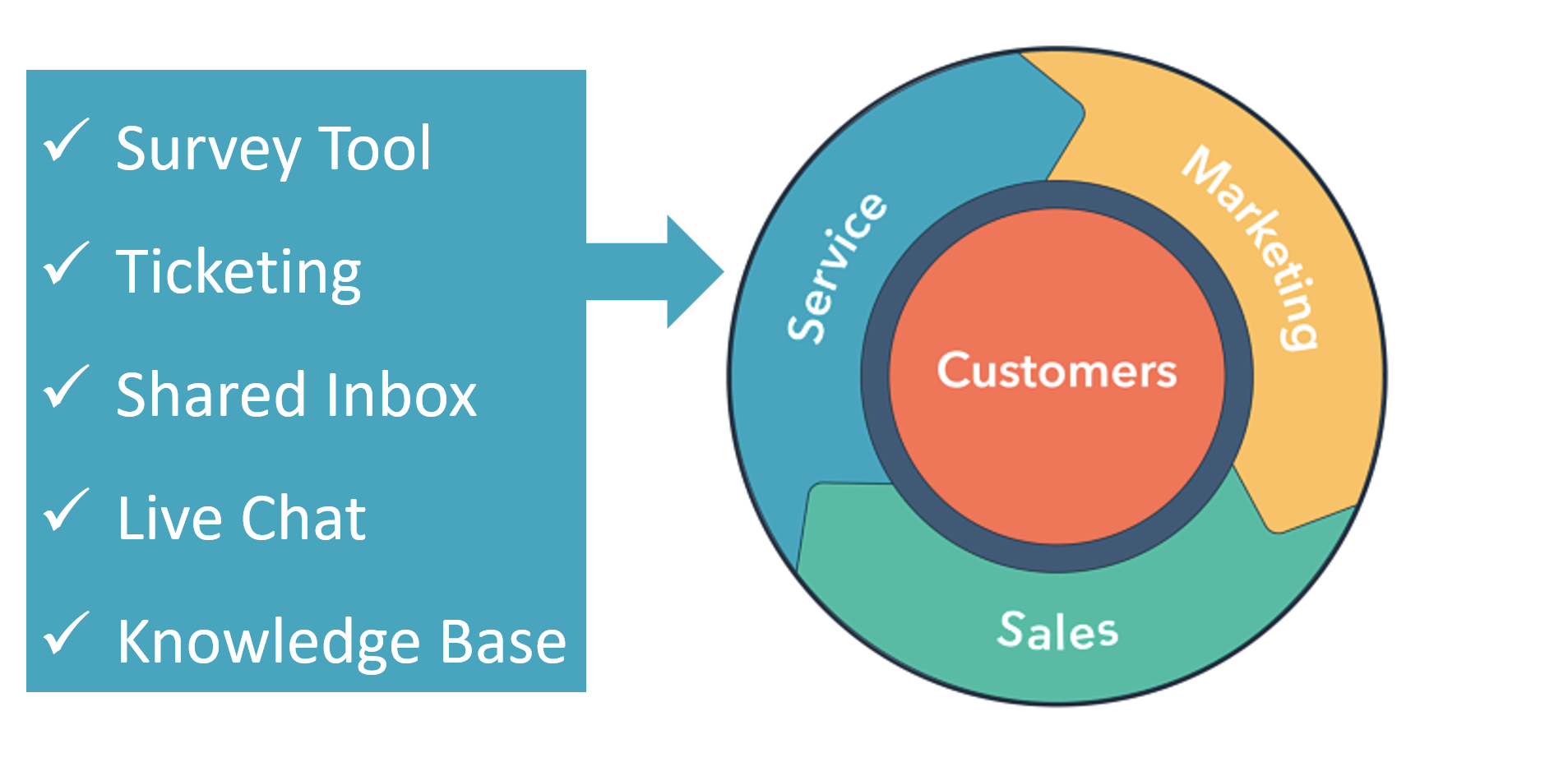Think about a customer service failure that you have experienced. Maybe you’ve been booted from an overbooked flight, dealt with a product return that took hours of your day, or paid for a software platform that did not live up to the hype promised.
Now, consider that some of your clients or customers could be having a similar experience that you are not aware of. Adopting this perspective is the first step of utilizing inbound methodologies in customer service–a mindset that put’s customer satisfaction at the forefront of your business operations.
Great customer service is more important than ever, with over 90% of today’s customers claiming they are more likely to make a repeat purchase from a brand with good customer service. This makes planning for quality customer service processes extremely valuable to your business.
Common roadblocks that might prevent teams from providing top customer service do not necessarily reflect on a company’s ‘people skills’ or customer service representatives. Roadblocks can occur due to low bandwidth or a lack of proper business processes in place. Adopting inbound methodologies in your customer service plan can optimize your customer service resources and allow you to provide authentic customer service at scale.
So, what is inbound customer service, and how can it be applied to businesses of any size? This article will break down how any business can utilize inbound customer service strategies to provide authentic customer service at scale.
What is Inbound Customer Service?
Related to inbound marketing, inbound customer service works to attract, engage, and delight customers to keep them returning to your business. Remember–customers report feeling more likely to become a repeat customer to a brand if they experience stellar service. Adopting inbound customer service philosophies focus on this goal of not just providing pleasant 1-off experiences for customers, but to nurture the customer experience in order to foster a loyal customer base.
Inbound methodologies can come into play in many customer service circumstances. Beyond working to “delight” customers in a regular customer interaction, inbound customer service can also be beneficial in trouble-shooting circumstances when a customer needs help and guidance.
Even when something may go wrong, delighting a customer can make or break a customer’s decision to return. Let’s look at a couple of examples:
- A customer experiences a delay receiving their order from an e-commerce store. In order to keep the customer satisfied and willing to shop on the site again, the business reimburses their shipping fees and provides the customer with a 15% off discount for their next purchase.
- A customer encounters confusion regarding how to navigate a website. Instead of leaving customers to their own devices, the business in question runs an FAQ page with a live chat function to answer any questions customers cannot find on the site. At the end of every live chat session, the customer can submit suggestions on how to improve the navigation of the website. Customers therefore feel heard, and the company can improve their UX based on real customer feedback.
- A B2C business notices a potential error on the customer’s end in an online order. Before delivering the order, the business has the foresight to confirm with the customer about whether or not their order is correct. This not only saves time and resources for the business, but prevents frustration for the customer.
In these scenarios, whether an error occurred on the business’s end or customer’s end, adding a personal touch to customer service makes a customer more likely to leave with a positive mindset. Acknowledging that mistakes happen, but addressing them graciously, aligns with the inbound principle of delighting customers to create lasting relationships. This makes the customers more likely to return or to leave a good review for the business.
Implementing Inbound Customer Service Framework
Delivering a personal touch with your customer service efforts will not remain sustainable without certain planning and guidelines in place. Implementing a set framework for your customer service makes it possible to consistently deliver quality service.
The most beneficial framework will include processes that are easy for your business to adhere to. This may include certain management tools and applications, an established list of protocols, proper customer service training, and clear communication within your team.
Let’s take a look at the following checklist for creating an effective inbound customer service framework:
- Make customer service a clear part of your UX - Businesses that do not make customer service resources readily available on their website are more likely to turn potential customers away, simply because a customer may not have a choice but to look somewhere else for services. Incorporating components such as FAQ pages, chatbots, live chat functions, and easy-to-find contact information will make the UX of your website more suited to supporting customer needs.
- Make use of Automation - Automation does not have to entail robotic, in-human interactions with customers. Many automation tools for customer service simply work to help prioritize and keep track of customer tickets. You might consider adopting a CRM platform to facilitate this. CRM (customer relationship management) platforms serve the purpose of nurturing and building relationships with customers. CRMs like HubSpot follow inbound methodologies to foster strong customer relationships. HubSpot also provides automated functions that eliminate a degree of manual labor from your customer service duties, preventing important interactions from slipping through the cracks.
- Read more about HubSpot’s Service Hub →
- Maintain internal organization - A business with poor internal organization will not be able to provide top-tier customer service. Even issues within peripheral teams can have major impacts on your service capabilities. If your company utilizes a project management software to keep organized and productive, this can play a key role in the internal aspect of your customer service. If your current project management approach is not working, it might be time to reevaluate and restructure. Make sure all of your teams have sufficient resources, accountability, and gameplans to follow through with internal work, so that customer relationships do not suffer.
- Create set guidelines for common customer service situations - When certain customer service issues occur, having set guidelines readily available for your team will ensure consistency and reliability in customer interactions. Consider drafting a list or flowchart of customer service protocols, which can guide service representatives whenever a situation prevents itself.
- Standardize internal communication - Certain customer service situations may arise that cannot be resolved by standard protocols. When a representative needs support from other team members, standardizing your team’s internal communications will improve efficiency and make sure everyone is on the same page. For customer communications, establish a chain of command in which a single point of contact (POC) interacts with the customer. It should also be predetermined who this POC can reach out to for particular needs, and when it is appropriate to involve additional team members in a customer service issue.
Maintaining Quality Customer Service While Scaling
Providing personalized and thorough customer service may sound like a heavy lift for businesses in the process of scaling. But by implementing inbound methodologies, businesses of any bandwidth should be able to develop a successful framework for top-tier customer service.
Scaling businesses currently struggling to maintain quality customer service may benefit from a restructuring or re-evaluation of their customer service protocols. Scaling business can consider:
- Are we using the correct CRM platform for our business size and industry?
- Do we need to make customer service resources more accessible on our site?
- Is it time for a check-in on our internal management and task organization?
- Can we restructure customer ticketing pipelines to make it easier to attend to customers?
- How can we delegate customer service duties to account for our current growing pains?
When in doubt, remember inbound thinking and return to the ultimate question:
-
How can we continue to engage, nurture, and delight customers during a transition period?
Even when bandwidth is low, you will have access to options that help you maintain authentic customer service during scaling periods.
Inbound AV is Here to Help
Inbound AV is here to support our clients’ efforts to improve and maintain quality customer interactions. This includes making customer service duties seamless and effective. We can provide key marketing services that remove burden from your team, making it easier for you to get back to delighting customers.
Interested in learning more?






